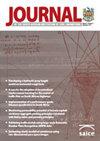槽形排水渠作为路面排水系统的截流能力
IF 0.6
4区 工程技术
Q4 ENGINEERING, CIVIL
Journal of the South African Institution of Civil Engineering
Pub Date : 2020-01-01
DOI:10.17159/2309-8775/2020/V62N4A2
引用次数: 0
摘要
本文回顾了以下两种槽式排水管的安装方案:一种是在没有中间屏障的情况下单独运行的槽式排水管,另一种是沿着排水管的纵向长度安装相邻屏障的槽式排水管。在模拟南非路面的各种典型条件时,对两种安装方案的拦截能力进行了实验审查和比较。在整个实验过程中,施加的板流、开槽入口尺寸和路面坡度(纵向和横向坡度)都是不同的。实验计算了开槽入口的拦截效率,计算结果为总拦截板流量与应用于路面布局的总板流量之比。分析了实验中应用的薄片流,以估计降雨强度和流深,这些降雨强度和流深通常会发生在不同的路面上,并对狭缝入口的拦截能力进行了审查。试验模拟的降雨强度大于1 000 mm/hr,流深大于10 mm。无论路面坡度值和槽式排水布置类型如何,超过98%的最大应用板流(约3.0磅/秒/米)被30毫米的槽式入口拦截。得出的结论是,在实际测试条件下运行的这两种开槽排水装置方案都有能力充分去除地表水,以促进潮湿路面条件下的道路安全。本文章由计算机程序翻译,如有差异,请以英文原文为准。
The interception capabilities of slotted drains as pavement surface drainage systems
The following two slotted drain installation scenarios were reviewed in this paper: a slotted drain operating individually without a median barrier and a slotted drain operating with an adjacent barrier installed along the longitudinal length of the drain. The interception capability of the two installation scenarios was experimentally reviewed and compared while imitating various conditions typically expected on South African pavements. The applied sheet flow, slotted inlet sizes and pavement slopes (longitudinal and cross slopes) were varied throughout the experiment. Interception efficiencies of the slotted inlets were experimentally calculated as a ratio of total intercepted sheet flow to the total sheet flow applied to the pavement layouts. The sheet flow applied during the experiment was analysed to estimate the rainfall intensities and flow depths that can typically occur on the different pavements for which the interception capability of the slotted inlets was reviewed. It was estimated that rainfall intensities of more than 1 000 mm/hr and flow depths higherthan 10 mm were imitated during the experiment. More than 98% of the maximum applied sheet flow of approximately 3.0 £/s/m was intercepted by the 30 mm slotted inlets regardless of the pavement slope values and type of slotted drain layout. The conclusion reached was that both these slotted drain installation scenarios operating in practice for the conditions tested would have the capability to sufficiently remove the surface water to promote road safety during wet pavement conditions.
求助全文
通过发布文献求助,成功后即可免费获取论文全文。
去求助
来源期刊
CiteScore
0.70
自引率
25.00%
发文量
19
审稿时长
>12 weeks
期刊介绍:
The Journal of the South African Institution of Civil Engineering publishes peer reviewed papers on all aspects of Civil Engineering relevant to Africa. It is an open access, ISI accredited journal, providing authoritative information not only on current developments, but also – through its back issues – giving access to data on established practices and the construction of existing infrastructure. It is published quarterly and is controlled by a Journal Editorial Panel.
The forerunner of the South African Institution of Civil Engineering was established in 1903 as a learned society aiming to develop technology and to share knowledge for the development of the day. The minutes of the proceedings of the then Cape Society of Civil Engineers mainly contained technical papers presented at the Society''s meetings. Since then, and throughout its long history, during which time it has undergone several name changes, the organisation has continued to publish technical papers in its monthly publication (magazine), until 1993 when it created a separate journal for the publication of technical papers.

 求助内容:
求助内容: 应助结果提醒方式:
应助结果提醒方式:


